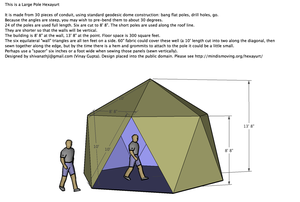
Available in other languages: /tr
Take your house. Cut off the water, the electrical power, the natural gas, and the sewage lines. That's what a hexayurt is like without the infrastructure systems which need to be shipped with it as an integral part of the housing system.
It helps to think of your own house as you go through this: replace each system in your mind with the one from the outline below. Remember that the systems are huge: the electrical system isn't the wires in your house, or strung along the poles outside. It's the power station, the huge transformers, the high voltage long distance lines, and the aspects of the government which regulate the grid, as well as the banking infrastructure to keep all that stuff paid for.
To provide services in the traditional way in the developing world is extremely difficult. Even though some of these line items look expensive, it's important to remember that they are very, very cheap compared to their first world equivalent service infrastructures!
Development Status[edit | edit source]
Together these systems appear to combine to provide the majority of the services provided by the pipe-and-wire infrastructure harness of a first world household for a cost in the neighbourhood of $200 per household for a relatively plush system, and a minimalist installation could be under $100 per household or less with more resource sharing.
The vast majority of the products required to put together this package are common, off-the-shelf items. However, very few if any of them have gone through the rigours of deployment in the field conditions we are talking about. The CCFL flashlights are an excellent example: available in stores for around $10, with an excellent battery life and 10,000 hour or better tubes, they appear perfect. But the are not waterproof, only water resistant.
What would the failure rate be if we deployed them in a refugee camp? Would the manufacturer - either Eveready, or the plant which makes them in China, be willing to make small design changes or product a special edition, or would we hit dead ends unless we were willing to have a custom model produced from scratch (a whole different line of business.)
My hope is that we can rely on the open source approach to solve many of these problems - that as long as all of our intellectual property is open, then domain experts can help us find answers to all the questions that come up, without feeling like they are helping a for-profit or partisan group. Free IP means freedom to participate for many people. We can give the companies who produce the products we want tweaked or improved the ideas on how to do it, and they can use them or not as they please.
My estimate is that it will take 10 to 15 years for this approach to be fully vested - tried in the field, failures identified and rectified, and technologies matured to the point where it becomes obvious to all parties that we have a scalable solution. Whole systems design is hard, and takes time, and a lot of lives are at stake.
But if we don't start now, we aren't going to have that fully finished solution 10 or 15 years down the line.
This is not to say that we could not push much harder and much faster - deploy units in the field and just see what happens, and learn by doing.
PS: the $200 number is padded for a more expensive toilet, and for a share of village-scale utilities like the one-per-village 2 kilowatt central power utility.
PPS: http://web.archive.org/web/20120820091728/http://www.rmi.org:80/sitepages/pid560.php (the Sustainable Settlements Charette, where a lot of the definition of scope happened)
http://web.archive.org/web/20150128031953/http://worldchanging.com:80/archives/002202.html (some older writing I did on infrastructure which might help fill in some details in my unusual perspective on this stuff.)